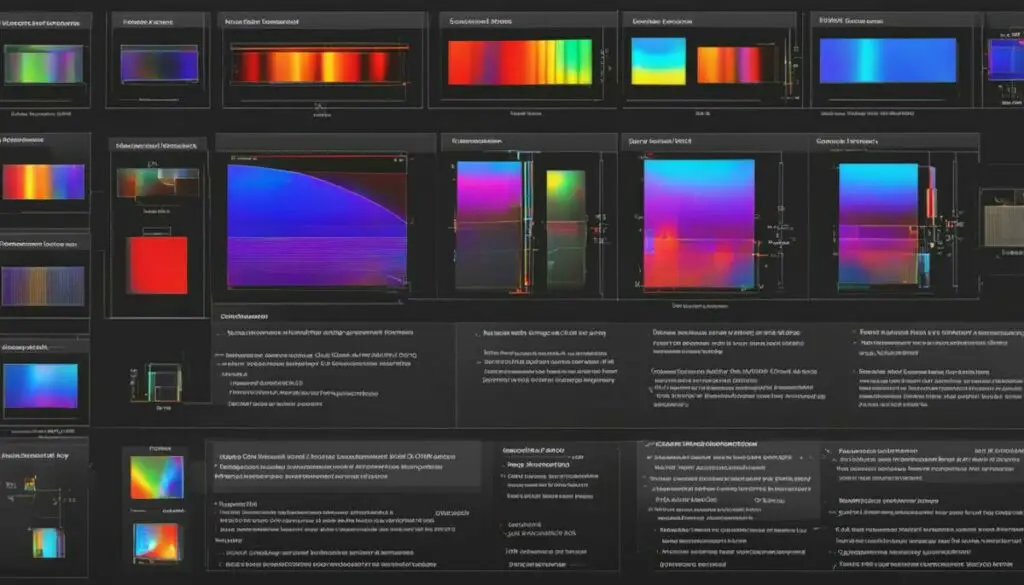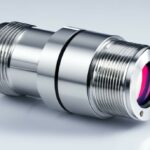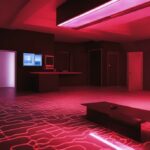Last Updated on 5 months by Francis
Infrared sensors have become ubiquitous in our daily lives, present in everything from home security systems to medical equipment. But how do infrared sensors work? How do they detect objects and measure temperature? In this section, we will explore the fascinating world of infrared sensor technology, uncovering the mechanics behind it and the theory that enables it to function.
Infrared sensor technology is a relatively recent innovation, with the first practical infrared sensor being developed in the 1950s. Since then, it has undergone significant advancements, leading to its wide use in various industries. Infrared sensors work by detecting and measuring electromagnetic radiation in the infrared range, which is invisible to the human eye.
So how exactly do infrared sensors work, and what makes them so important in today’s world? Let’s dive into the basics and explore the working principles and components of infrared sensors.
Contents
Key Takeaways:
- Infrared sensors detect and measure electromagnetic radiation in the infrared range.
- Infrared sensor technology is a recent innovation developed in the 1950s.
- Infrared sensors are widely used in various industries, from security systems to medical equipment.
- Infrared sensors work by detecting heat radiation or light, converting it into an electrical signal and processing it.
- The unique properties of infrared sensors make them ideal for numerous applications, and they offer several advantages over other sensing technologies.
The Basics of Infrared Sensors

Before we dive into the specifics of infrared sensors, let’s start by understanding their working principle. Infrared sensors detect and measure the infrared radiation emitted by an object, and they convert this radiation into an electrical signal, which is then analyzed by a microprocessor to determine the temperature, position, or presence of the object.
The types of infrared sensors can be broadly classified into two categories: thermal and quantum. Thermal infrared sensors work by detecting the heat radiated from an object, whereas quantum infrared sensors detect the energy absorbed or emitted when electrons transition between energy levels in the quantum state of atoms or molecules.
Thermal infrared sensors, also known as thermopiles, use a series of thermocouples to detect infrared radiation and produce a voltage proportional to the temperature of the object being measured. These sensors can be used for a range of applications, such as temperature measurement in industrial processes and medical devices.
Quantum infrared sensors, also called photodetectors, use a semiconductor material to detect the absorption or emission of infrared radiation. These sensors are highly sensitive and can operate at room temperature, making them ideal for applications such as night vision, remote sensing, and spectroscopy.
Both thermal and quantum infrared sensors have their advantages and limitations, depending on the application requirements. Thermal sensors are cost-effective and have high accuracy, but they have a slow response time and can’t detect small temperature variations. Quantum sensors, on the other hand, have a faster response time and are more sensitive to low levels of radiation, but they are more expensive and have higher power consumption.
In the next section, we will explore how infrared sensors detect objects and the diverse range of applications they find in various industries.
Infrared Sensor Detection: How It Works

Now that we understand the basic workings of infrared sensors, let’s explore how they detect objects and their diverse range of applications in various industries. Infrared sensor detection works on the principle of detecting the infrared radiation emitted by an object and measuring the intensity of that radiation. Objects, both living and non-living, emit varying levels of infrared radiation depending on their temperature, and this radiation is detected by the infrared sensor.
The detection process begins with the infrared sensor emitting a beam of infrared radiation towards the targeted object. This beam is then reflected back to the infrared sensor, where it is measured and analyzed to detect the presence or absence of an object, as well as its temperature.
Infrared Sensor Applications
Infrared sensors have a wide range of practical applications in various industries. For example, they are commonly used in security systems, where they can detect movement and trigger alarms or cameras. They are also used in temperature measurement systems, where they can measure the temperature of objects without making contact, making them ideal for use in high-risk environments such as chemical plants or nuclear reactors.
In addition, infrared sensors are used in the healthcare industry to monitor patients’ body temperature and detect anomalies or infections. They are also used in the automotive industry for driver assistance systems, such as automatic braking and collision avoidance.
“The combination of accuracy and versatility make infrared sensors ideal for a wide range of applications, from security to healthcare to automotive.”
As technology continues to advance, the applications for infrared sensors will only continue to expand, making them an essential component of many industries and technologies.
The Theory Behind Infrared Sensors

Infrared sensors work by detecting the radiation emitted by objects in the infrared spectrum. The sensors are designed to detect heat and motion, making them useful in a wide range of applications. Infrared sensors can detect the presence of an object, the movement of an object, or the temperature of an object.
The underlying theory behind infrared sensors is based on the laws of thermodynamics. These laws govern the behavior of heat, energy, and motion. Infrared sensors use these laws to detect the radiation emitted by objects in the infrared spectrum. The sensors are designed to detect the changes in the level of radiation emitted by objects, which are caused by changes in temperature or movement.
The technology behind infrared sensors is complex, and it involves a range of components that work together to detect and analyze infrared radiation. These components include the sensor itself, which is typically made from a semiconductor material such as silicon or germanium, and a lens, which is used to focus the infrared radiation onto the sensor. The electronics used to control the sensor and analyze the signals are also critical components.
The operation of infrared sensors is based on the interaction between the sensor and the infrared radiation emitted by objects. When an object emits infrared radiation, it is absorbed by the sensor. The absorbed radiation generates a heat source within the sensor, which produces an electric current that is proportional to the amount of radiation absorbed. This current is then amplified and analyzed by the electronics to determine the presence, movement, or temperature of the object.
Infrared Sensor Technology Explanation
The technology behind infrared sensors has evolved significantly over the last few decades, enabling the development of more advanced sensors with improved accuracy and sensitivity. The development of microelectromechanical systems (MEMS) technology has enabled the manufacture of tiny sensors that can be integrated into a wide range of devices, such as smartphones, cameras, and medical equipment.
The latest infrared sensor technology also allows for the detection of a wider range of wavelengths, enabling the sensors to detect objects that were previously invisible to the naked eye. This technology has led to the development of new applications, such as the detection of gas leaks and the analysis of the composition of materials.
“The underlying theory behind infrared sensors is based on the laws of thermodynamics. These laws govern the behavior of heat, energy, and motion.”
Overall, the theory behind infrared sensors is based on the principles of thermodynamics, which govern the behavior of heat, energy, and motion. The technology behind infrared sensors is complex, involving a range of components and advanced electronics. However, the benefits of using infrared sensors are many, including their ability to detect the presence, movement, and temperature of objects. The latest infrared sensor technology has opened up a range of new applications, which will undoubtedly continue to grow in the future.
Components of Infrared Sensors

Now that we have a basic understanding of infrared sensors, let’s take a closer look at the essential components that make up these technological marvels:
| Component | Description |
|---|---|
| Emitter | This component emits infrared rays towards the target object. |
| Detector | This component detects the infrared rays reflected from the target object. |
| Signal Processor | This component processes the signal received from the detector and provides an output indicating the presence or absence of the target object. |
The emitter and detector are usually placed in close proximity to each other, and the signal processor is placed in between them. This allows for the detection of objects in the line of sight. The sensitivity of the detector component is vital to ensure accurate detection, and it varies depending on the type of infrared sensor being used.
Other components that may be included in infrared sensors are lenses, filters, and amplifiers. Lenses are used to focus the infrared rays towards the target object, while filters are used to eliminate unwanted reflections. Amplifiers will boost the signal output to increase the detection range of the sensor.
Understanding the various components of infrared sensors is crucial in determining their effectiveness and range of application. By working together, these components allow for the detection of objects based on their infrared radiation signature, enabling the creation of sophisticated security systems, temperature measurement devices, and many other applications.
Infrared Sensor Technology: Explained

Understanding infrared sensor technology can seem like a daunting task, but it’s crucial to recognize the key principles that make this technology work. Infrared sensors function based on the interaction of objects and electromagnetic radiation. Unlike visible light, which is reflected by objects, infrared radiation is emitted by all objects above absolute zero temperature. Infrared sensors detect these emissions and convert them into an electrical signal that can be processed and interpreted.
The key components of an infrared sensor include an infrared source, a detector, and an electronic signal processor. When an infrared source emits radiation, the detector measures the amount of radiation that is absorbed or emitted by an object. The processor then converts this information into an electrical signal that can be analyzed for further application.
One of the most significant advantages of infrared sensor technology is its ability to detect objects that are not visible to the naked eye. This makes it a valuable tool in various industries, including security systems, motion detection, and temperature measurement. For instance, in security systems, infrared sensors can detect the presence of a person in a room by sensing their body heat, ensuring that the system is only activated when someone is present, while avoiding false alarms.
Another fascinating application of infrared sensors is in temperature measurement. Infrared sensors can detect the amount of infrared radiation emitted by an object, which is directly related to its temperature. This allows for non-contact temperature measurement, which is particularly useful in industrial processes where contact-based measurements can be challenging or unsafe.
How Does Infrared Sensor Technology Work in Cameras?
Infrared sensor technology is also widely used in cameras, particularly in night vision applications. Infrared cameras have an infrared light source that emits radiation, which is then reflected by objects in the scene. The reflected radiation is detected by the camera’s infrared sensor, which converts it into an electrical signal that can be used to form an image.
However, it’s important to note that not all objects emit the same amount of infrared radiation. Some objects, such as glass and metals, reflect infrared radiation, which can affect the accuracy of the measurement. To overcome this, modern infrared cameras use algorithms to compensate for the reflective properties of different materials, ensuring that the image produced accurately reflects the temperature of the object being measured.
“Infrared sensors are a vital component of modern technology, helping us to see and measure things that are beyond the scope of our ordinary senses.”
Infrared Sensor Applications

The applications of infrared sensors are widespread and diverse, with their use present in many industries. Their capability to detect infrared light emissions makes them ideal for various purposes, ranging from temperature measurement to security systems.
Security Systems
Infrared sensors are used in security systems to detect movements and trigger alarms. They provide an efficient and accurate way to secure a property, from homes to commercial buildings. When someone or something moves within the range of an infrared sensor, it detects the infrared radiation emitted and activates an alarm or alert. This technology is commonly used in motion-detection cameras, door sensors, and security lighting systems.
Temperature Measurement
Infrared sensors are frequently used for non-contact temperature measurement, especially in industries that require accurate readings of high temperatures. The sensors detect the infrared radiation emitted by an object and convert it into temperature data. Infrared thermometers are widely used in the food industry to check the temperature of food products, as well as in the automotive industry to monitor the temperature of engines and brakes.
Industrial Control Systems
Infrared sensors are used in industrial control systems to monitor equipment performance and detect potential malfunctions. By measuring the temperature of specific equipment parts or components, the sensors can identify overheating or other anomalies, allowing for timely corrective action that can prevent costly breakdowns or accidents.
Medical Industry
Infrared sensors are widely used in the medical industry to measure body temperature, detect infections, and assist in medical imaging. Infrared thermometers are frequently used in hospitals and clinics to measure the temperature of patients, without having to make physical contact. Infrared sensors are also used in medical imaging equipment, such as X-ray machines, to detect and generate images of internal organs and other body parts.
“Infrared sensors have a significant contribution in various industries such as medical, security, industrial control, and more.”
Overall, the applications of infrared sensors continue to grow and expand, as new technologies and industries emerge. Their versatility and accuracy make them an essential tool in many industries, providing reliable and efficient solutions to various challenges.
Advantages and Limitations of Infrared Sensors
As with any technology, there are advantages and limitations to using infrared sensors. Let’s examine the benefits and potential drawbacks of this fascinating innovation.
Advantages of Infrared Sensors
One of the primary advantages of infrared sensors is their ability to detect and measure temperature without making contact with the object, making them ideal for use in applications where physical contact is not possible or desirable. This makes them an essential tool in the fields of industrial automation, manufacturing, and HVAC systems, where temperature control is critical.
Infrared sensors are also commonly used in security systems, where they can detect motion and monitor the presence of intruders, helping to keep people and property safe. They are also used in medical equipment, where they can detect the presence of certain medical conditions by measuring temperature changes in the body.
Another advantage of infrared sensors is their ability to operate in conditions where visible light is not present, such as in low light or complete darkness. This makes them effective in applications such as night vision cameras and military equipment.
Limitations of Infrared Sensors
While infrared sensors have many advantages, there are also some limitations to their use. For example, they are highly sensitive to environmental factors such as temperature and humidity, which can affect their accuracy and reliability. In addition, infrared sensors can be impacted by the presence of other sources of heat and light, which can interfere with their readings and cause inaccuracies.
Another limitation of infrared sensors is their range, which can be limited by the size and power of the sensor. This can affect their effectiveness in certain applications, particularly those that require long-range detection or measurement.
Overall
In conclusion, while there are limitations to using infrared sensors, their many advantages make them a valuable tool in a wide range of industries. By understanding their strengths and potential drawbacks, we can make informed decisions about how best to utilize this innovative technology.
Conclusion
After exploring the world of infrared sensor technology, it becomes evident that these sensors possess immense potential in various industries across the globe. The working principles behind infrared sensors and the application of this technology is remarkable.
From security systems to temperature measurement, infrared sensors play a significant role in enhancing our daily lives. The technology behind infrared sensors is complex, but by understanding the basics and their operation, it is clear that their value cannot be overstated.
Advantages and Limitations
While infrared sensors have various advantages in terms of application, such as their ability to detect motion and temperature changes, they also have limitations. One of the key limitations is their inability to detect objects that are not within their line of sight, such as behind walls.
Despite this, the advantages of using infrared sensors far outweigh the limitations. Their compact size, accuracy and cost-effectiveness make them invaluable in many industries.
Looking Forward
The advancements in infrared sensor technology will revolutionize various industries in the coming years. The integration of infrared sensors with artificial intelligence and machine learning will enhance their functionality and open up new possibilities in terms of applications.
As we continue to push the bounds of what is possible, it is clear that infrared sensor technology will play an increasingly significant role in transforming our daily lives.
FAQ
How do infrared sensors work?
Infrared sensors work by detecting and measuring infrared radiation, which is emitted by objects in the form of heat. They use different technologies, such as passive infrared (PIR) or active infrared (AIR), to detect this radiation and convert it into an electrical signal that can be processed by the sensor.
What are the types of infrared sensors?
There are various types of infrared sensors, including passive infrared (PIR) sensors, active infrared (AIR) sensors, thermal infrared sensors, and near-infrared (NIR) sensors. Each type has its own specific applications and working principles.
How does infrared sensor detection work?
Infrared sensor detection works by analyzing the changes in infrared radiation levels. For example, a PIR sensor detects the changes in heat patterns caused by moving objects, while an AIR sensor emits infrared light and measures the reflections to determine the presence of objects.
What is the theory behind infrared sensors?
The theory behind infrared sensors is based on the principle that all objects with a temperature above absolute zero emit infrared radiation. Infrared sensors detect and measure this radiation, allowing them to identify objects and measure their temperature.
What are the components of infrared sensors?
Infrared sensors typically consist of a sensor element, a lens or window, a filter, and electronic circuitry. The sensor element is responsible for converting the infrared radiation into an electrical signal, while the lens or window focuses the radiation onto the sensor. The filter helps eliminate unwanted frequencies, and the electronic circuitry processes the signal for further analysis.
How does infrared sensor technology work?
Infrared sensor technology works by utilizing the principles of infrared radiation and its interaction with objects. This technology enables the detection, measurement, and analysis of infrared radiation, providing valuable insights and applications in various industries.
What are the applications of infrared sensors?
Infrared sensors have diverse applications, including security systems, motion detection, temperature measurement, gas monitoring, industrial automation, healthcare devices, and smart home technology. They are used in sectors such as aerospace, automotive, manufacturing, and more.
What are the advantages and limitations of infrared sensors?
Some advantages of infrared sensors include their ability to operate in harsh environments, their non-contact nature, and their capability to detect objects in low light or obscured conditions. However, they have limitations such as limited range, sensitivity to environmental factors, and potential interference from other sources of infrared radiation.








